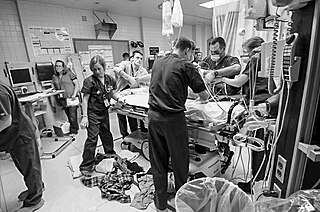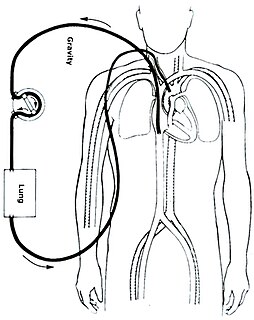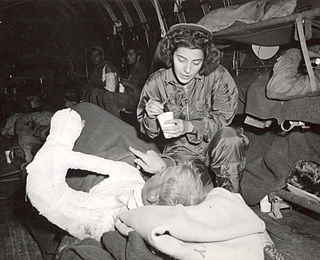Related Research Articles

Emergency medicine, also known as accident and emergency medicine, is the medical specialty concerned with the care of illnesses or injuries requiring immediate medical attention. Emergency physicians care for unscheduled and undifferentiated patients of all ages. As first-line providers, their primary responsibility is to initiate resuscitation and stabilization and to start investigations and interventions to diagnose and treat illnesses in the acute phase. Emergency physicians generally practise in hospital emergency departments, pre-hospital settings via emergency medical services, and intensive care units, but may also work in primary care settings such as urgent care clinics. Sub-specializations of emergency medicine include disaster medicine, medical toxicology, ultrasonography, critical care medicine, hyperbaric medicine, sports medicine, palliative care, or aerospace medicine.

An emergency medical technician (EMT), also known as an ambulance technician, is a health professional that provides emergency medical services. EMTs are most commonly found working in ambulances. In English-speaking countries, paramedics are a separate profession that has additional educational requirements, qualifications, and scope of practice.

A paramedic is a health care professional whose primary role is to provide advanced emergency medical care for critical and emergent patients who access the emergency medical system.

An emergency department (ED), also known as an accident & emergency department (A&E), emergency room (ER), emergency ward (EW) or casualty department, is a medical treatment facility specializing in emergency medicine, the acute care of patients who present without prior appointment; either by their own means or by that of an ambulance. The emergency department is usually found in a hospital or other primary care center.

A trauma center is a hospital equipped and staffed to provide care for patients suffering from major traumatic injuries such as falls, motor vehicle collisions, or gunshot wounds. A trauma center may also refer to an emergency department without the presence of specialized services to care for victims of major trauma.
Peter Safar was an Austrian anesthesiologist of Czech descent. He is credited with pioneering cardiopulmonary resuscitation (CPR).

Extracorporeal membrane oxygenation (ECMO), also known as extracorporeal life support (ECLS), is an extracorporeal technique of providing prolonged cardiac and respiratory support to persons whose heart and lungs are unable to provide an adequate amount of gas exchange or perfusion to sustain life. The technology for ECMO is largely derived from cardiopulmonary bypass, which provides shorter-term support with arrested native circulation. The device used is a membrane oxygenator, also known as an artificial lung.

Major trauma is any injury that has the potential to cause prolonged disability or death. There are many causes of major trauma, blunt and penetrating, including falls, motor vehicle collisions, stabbing wounds, and gunshot wounds. Depending on the severity of injury, quickness of management, and transportation to an appropriate medical facility may be necessary to prevent loss of life or limb. The initial assessment is critical, and involves a physical evaluation and also may include the use of imaging tools to determine the types of injuries accurately and to formulate a course of treatment.

Artificial ventilation is a means of assisting or stimulating respiration, a metabolic process referring to the overall exchange of gases in the body by pulmonary ventilation, external respiration, and internal respiration. It may take the form of manually providing air for a person who is not breathing or is not making sufficient respiratory effort, or it may be mechanical ventilation involving the use of a mechanical ventilator to move air in and out of the lungs when an individual is unable to breathe on their own, for example during surgery with general anesthesia or when an individual is in a coma or trauma.
WebMD is an American corporation known primarily as an online publisher of news and information pertaining to human health and well-being. The site includes information pertaining to drugs. It is one of the top healthcare websites by unique visitors.

A cervical collar, also known as a neck brace, is a medical device used to support a person's neck. It is also applied by emergency personnel to those who have had traumatic head or neck injuries, and can be used to treat chronic medical conditions.
An emergency physician is a physician who works at an emergency department to care for ill patients. The emergency physician is a specialist in advanced cardiac life support, resuscitation, trauma care such as fractures and soft tissue injuries, and management of other life-threatening situations.

A trauma team is a multidisciplinary group of healthcare workers under the direction of a team leader, who work together to assess and treat the severely injured.This team typically meets before the patient reaches the trauma center. Upon arrival, the team does an initial assessment and necessary resuscitation, adhering to a defined protocol.

R Adams Cowley Shock Trauma Center is a free-standing trauma hospital in Baltimore, Maryland and is part of the University of Maryland Medical Center. It was the first facility in the world to treat shock. Shock Trauma was founded by R Adams Cowley, considered the father and major innovator of trauma medicine.
The Center for Emergency Medicine of Western Pennsylvania is a multi-hospital consortium based in Pittsburgh, Pennsylvania. It is claimed to be one of the world's premiere

Emergency medical services in France are provided by a mix of organizations under public health control. The central organizations that provide these services are known as a SAMU, which stands for Service d'Aide Médicale Urgente. Local SAMU organisations operate the control rooms that answer emergency calls and dispatch medical responders. They also operate the SMUR, which refers to the ambulances and response vehicles that provide advanced medical care. Other ambulances and response vehicles are provided by the fire services and private ambulance services.

A flight nurse is a registered nurse who specialises in the field of providing comprehensive pre-hospital, emergency critical care, and hospital care to a vast scope of patients. The care of these patients is generally during aeromedical evacuation or rescue operations aboard helicopters, propeller aircraft or jet aircraft. On board a rescue aircraft you would find a flight nurse accompanied by flight medics and respiratory practitioners, as well as the option of a flight physician for comprehensive emergency and critical transport teams. The inclusion of a flight physician is more commonly seen in pediatric and neonatal transport teams. A critical care flight nurse must be able to deal with all age groups with broad critical emergencies. With no physicians on site the nurses scope of practice is expanded. The critical care experience is transferred over to a flight nurse with impacting factors such as altitude and changes in pressure, gravitational forces, and weather. Some patients may experience exacerbation's because of factors related to the cabin environment including hypoxia, limited mobility, gas expansion, and risk of injury related to turbulence and resources with definitive care are limited. Aeromedical evacuation crews coordinate coordinate with other organizations to plan for the safe and timely care and evacuation of patients. Crews must be prepared for patients suffering from trauma and mental health illnesses.
The following outline is provided as an overview of and topical guide to emergency medicine:
Extracorporeal cardiopulmonary resuscitation is a method of cardiopulmonary resuscitation (CPR) that passes the patient's blood through a machine in a process to oxygenate the blood supply. A portable extracorporeal membrane oxygenation (ECMO) device is used as an adjunct to standard CPR. A patient who is deemed to be in cardiac arrest refractory to CPR has percutaneous catheters inserted into the femoral vein and artery. Theoretically, the application of ECPR allows for the return of cerebral perfusion in a more sustainable manner than with external compressions alone. By attaching an ECMO device to a person who has acutely undergone cardiovascular collapse, practitioners can maintain end-organ perfusion whilst assessing the potential reversal of causal pathology, with the goal of improving long-term survival and neurological outcomes.
The management of COVID-19 includes supportive care, which may include fluid therapy, oxygen support, and supporting other affected vital organs. The WHO is in the process of including dexamethasone in guidelines for treatment for hospitalized patients, and it is recommended for consideration in Australian guidelines for patients requiring oxygen. CDC recommends those who suspect they carry the virus wear a simple face mask. Extracorporeal membrane oxygenation (ECMO) has been used to address the issue of respiratory failure, but its benefits are still under consideration. Personal hygiene and a healthy lifestyle and diet have been recommended to improve immunity. Supportive treatments may be useful in those with mild symptoms at the early stage of infection. Nasal breathing is suggested as such a procedure based on several peer reviewed studies.
References
- ↑ "What it's like in critical care medicine". American Medical Association. Archived from the original on 14 March 2020. Retrieved 13 March 2020.
The online resource students interested in pulmonary and critical care medicine should follow…EMCrit, a blog about emergency medicine and critical care.
- ↑ Simpson, Elizabeth (17 May 2017). "Vitamin C as sepsis treatment: Should doctors wait for proof, or treat dying patients now?". The Virginian-Pilot. Archived from the original on 24 January 2020. Retrieved 13 March 2020.
- ↑ Christopher M. Tedeschi MD MA (28 July 2017). "Notes From a Most Unusual Critical Care Conference". Medscape . WebMD. Archived from the original on 14 August 2019. Retrieved 13 March 2020.
FOAMed has its roots in a loosely organized but influential community of bloggers and podcasters. EmCrit, arguably the most popular EM–critical care-focused site, boasts more than 34,000 Twitter followers.
- 1 2 "Department of Emergency Medicine". Renaissance School of Medicine. Archived from the original on 14 March 2020. Retrieved 13 March 2020.
- ↑ "Faculty". Reanimate Conference. Retrieved 2020-08-28.
- ↑ "CME for Critical Care". EMCrit/EB Medicine. 22 December 2014. Archived from the original on 3 April 2019. Retrieved 13 March 2020.
- ↑ "The Resuscitation Crisis Manual". Leeuwin Press. Archived from the original on 16 June 2019. Retrieved 13 March 2020.
- ↑ "The University of Vermont Medical Center". University of Vermont Medical Center. Archived from the original on 14 March 2020. Retrieved 12 March 2020.
- ↑ Farkas, Josh (March 2020). "COVID19". The Internet Book of Critical Care (digital) (Reference manual). USA: EMCrit. Archived from the original on 11 March 2020. Retrieved 13 March 2020.
- ↑ "A List of Resources for COVID 19: Scientific and medical data". Princeton University Library. 13 March 2020. Archived from the original on 14 March 2020. Retrieved 13 March 2020.
- ↑ "COVID19 - Resources for Health Care Professionals". Penn Libraries. 11 March 2020. Archived from the original on 14 March 2020. Retrieved 13 March 2020.